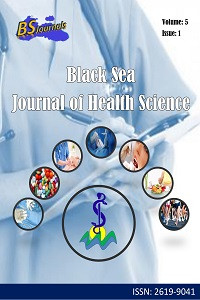Abstract
Negative pressure pulmonary edema (NPPE) is one of the causes of noncardiogenic pulmonary edema. The common mechanism in patients with NPPE; It is an airway obstruction caused by laryngospasm following the patient's extubation after general anesthesia. A fifty-year-old male patient was operated under general anesthesia due to rupture of the achilles tendon. The patient, who started to complain of sore throat and cough postoperatively, and thoracic computed tomography (CT) findings suggestive of COVID-19, was diagnosed with NPPE. Improvement was seen secondary to continuous positive airway pressure (CPAP) and diuretic therapy. The radiological findings regressed on the 10th postoperative day. After NBAÖ general anesthesia; it is among the pulmonary complications that may develop after extubation, secondary to laryngospasm or without laryngospasm.
References
- Arita Y, Yamamoto S, Eda Y, Hasegawa S. 2018. Negative pressure pulmonary edema. Intern Med Tokyo Jpn, 57(24): 3673-3674.
- Bhalotra AR. 2018. Negative pressure pulmonary edema. Korean J Anesthesiol, 71(1): 71-72. DOI: 10.4097/kjae.2018.71.1.71.
- Bhattarai B, Shrestha S. 2011. Negative pressure pulmonary edema-case series and review of literature. Kathmandu Univ Med J KUMJ, 9(36): 310-315. DOI: 10.3126/kumj.v9i4.6352.
- Erden B, Ak S, Çiftçi F. 2020. Negative-pressure pulmonary edema after septoplasty. J Craniofac Surg, 31(3): e270-e272.
- García de Hombre AM, Cuffini A, Bonadeo A. 2013. Negative pressure pulmonary oedema after septoplasty. Acta Otorrinolaringol Engl Ed., 64(4): 300-302.
- Hani C, Trieu NH, Saab I. 2020. COVID-19 pneumonia: a review of typical CT findings and differential diagnosis. Diagn Interv Imaging, 101(5): 263-268. DOI: 10.1016/j.diii.2020.03.014.
- Holzgreve A, Fabritius MP, Conter P. 2020. CT Findings in negative pressure pulmonary edema. Diagn Basel Switz, 10(10): 749. DOI: 10.3390/diagnostics10100749.
- Karaman I, Ozkaya S. 2020. Differential diagnosis of negative pressure pulmonary edema during COVID-19 pandemic. J Craniofac Surg, 32(5): e421-e423.
- Lawrence VA, Cornell JE, Smetana GW. 2006. American College of Physicians. Strategies to reduce postoperative pulmonary complications after noncardiothoracic surgery: systematic review for the American College of Physicians. Ann Intern Med, 144(8): 596-608.
- Liu R, Wang J, Zhao G, Su Z. 2019. Negative pressure pulmonary edema after general anesthesia: A case report and literature review. Medicine (Baltimore), 98(17): e15389. DOI: 10.1097/MD.0000000000015389.
- Wang D, Hu B, Hu C. 2019. Clinical characteristics of 138 hospitalized patients with 2019 novel coronavirus-ınfected pneumonia in Wuhan, China. JAMA, 323(11): 1061-1069.
Abstract
Negatif basınçlı akciğer ödemi (NBAÖ) nonkardiyojenik pulmoner ödem nedenlerinden birisi olarak kabul edilmektedir. Negatif basınçlı akciğer ödemi gelişen hastalardaki ortak mekanizma; hastanın genel anesteziden sonra ekstübasyonunu takip eden laringospazmın neden olduğu bir hava yolu obstrüksiyonudur. Elli yaşında, erkek hasta aşil tendon rüptürü nedeniyle genel anestezi altında opere edildi. Postoperatif boğaz ağrısı ve öksürük şikayeti başlayan ve toraks bilgisayarlı tomografi (BT) bulguları ile COVID-19’u düşündüren hastaya NBAÖ tanısı konuldu. Sürekli pozitif havayolu basıncı (CPAP) ve diüretik tedavisine sekonder iyileşme görüldü. Postoperatif 10. günde radyolojik bulguları geriledi. NBAÖ genel anestezi sonrasında; laringospazma sekonder ya da laringospazm olmaksızın, ekstübasyon sonrasında gelişebilecek pulmoner komplikasyonlar arasındadır.
References
- Arita Y, Yamamoto S, Eda Y, Hasegawa S. 2018. Negative pressure pulmonary edema. Intern Med Tokyo Jpn, 57(24): 3673-3674.
- Bhalotra AR. 2018. Negative pressure pulmonary edema. Korean J Anesthesiol, 71(1): 71-72. DOI: 10.4097/kjae.2018.71.1.71.
- Bhattarai B, Shrestha S. 2011. Negative pressure pulmonary edema-case series and review of literature. Kathmandu Univ Med J KUMJ, 9(36): 310-315. DOI: 10.3126/kumj.v9i4.6352.
- Erden B, Ak S, Çiftçi F. 2020. Negative-pressure pulmonary edema after septoplasty. J Craniofac Surg, 31(3): e270-e272.
- García de Hombre AM, Cuffini A, Bonadeo A. 2013. Negative pressure pulmonary oedema after septoplasty. Acta Otorrinolaringol Engl Ed., 64(4): 300-302.
- Hani C, Trieu NH, Saab I. 2020. COVID-19 pneumonia: a review of typical CT findings and differential diagnosis. Diagn Interv Imaging, 101(5): 263-268. DOI: 10.1016/j.diii.2020.03.014.
- Holzgreve A, Fabritius MP, Conter P. 2020. CT Findings in negative pressure pulmonary edema. Diagn Basel Switz, 10(10): 749. DOI: 10.3390/diagnostics10100749.
- Karaman I, Ozkaya S. 2020. Differential diagnosis of negative pressure pulmonary edema during COVID-19 pandemic. J Craniofac Surg, 32(5): e421-e423.
- Lawrence VA, Cornell JE, Smetana GW. 2006. American College of Physicians. Strategies to reduce postoperative pulmonary complications after noncardiothoracic surgery: systematic review for the American College of Physicians. Ann Intern Med, 144(8): 596-608.
- Liu R, Wang J, Zhao G, Su Z. 2019. Negative pressure pulmonary edema after general anesthesia: A case report and literature review. Medicine (Baltimore), 98(17): e15389. DOI: 10.1097/MD.0000000000015389.
- Wang D, Hu B, Hu C. 2019. Clinical characteristics of 138 hospitalized patients with 2019 novel coronavirus-ınfected pneumonia in Wuhan, China. JAMA, 323(11): 1061-1069.
Details
| Primary Language | Turkish |
|---|---|
| Subjects | Surgery |
| Journal Section | Case Report |
| Authors | |
| Publication Date | January 1, 2022 |
| Submission Date | June 17, 2021 |
| Acceptance Date | August 4, 2021 |
| Published in Issue | Year 2022 Volume: 5 Issue: 1 |


